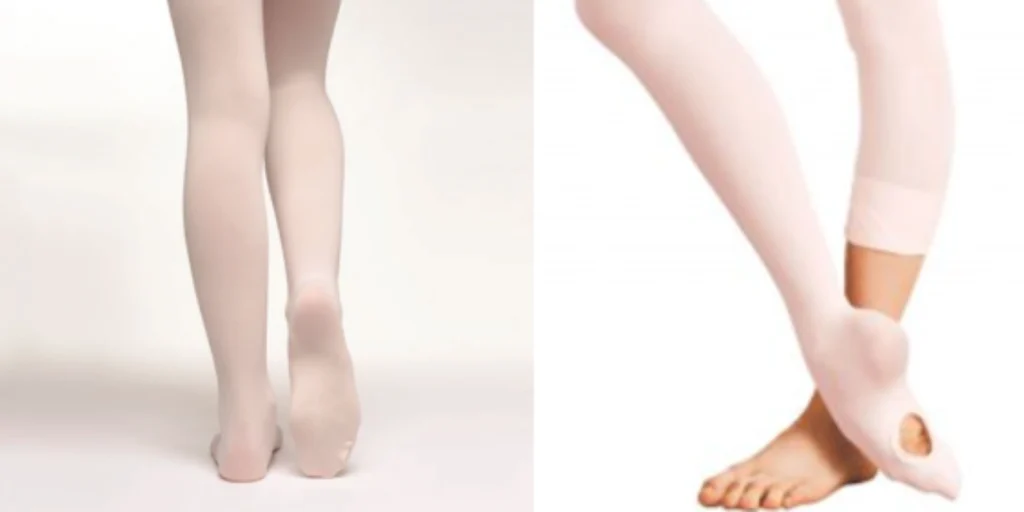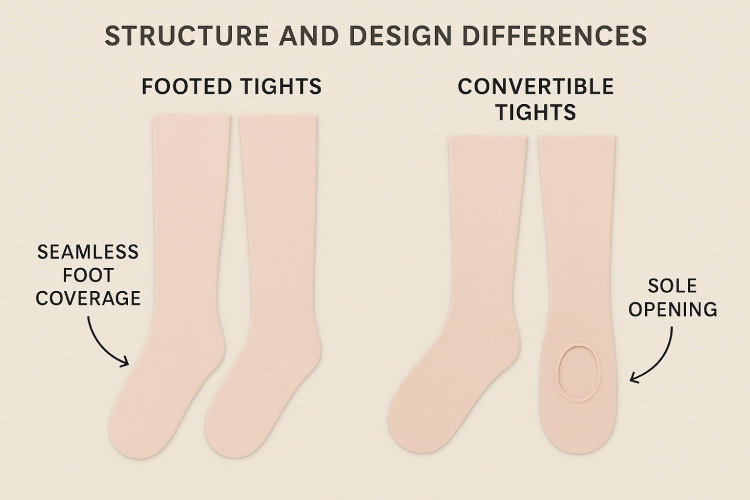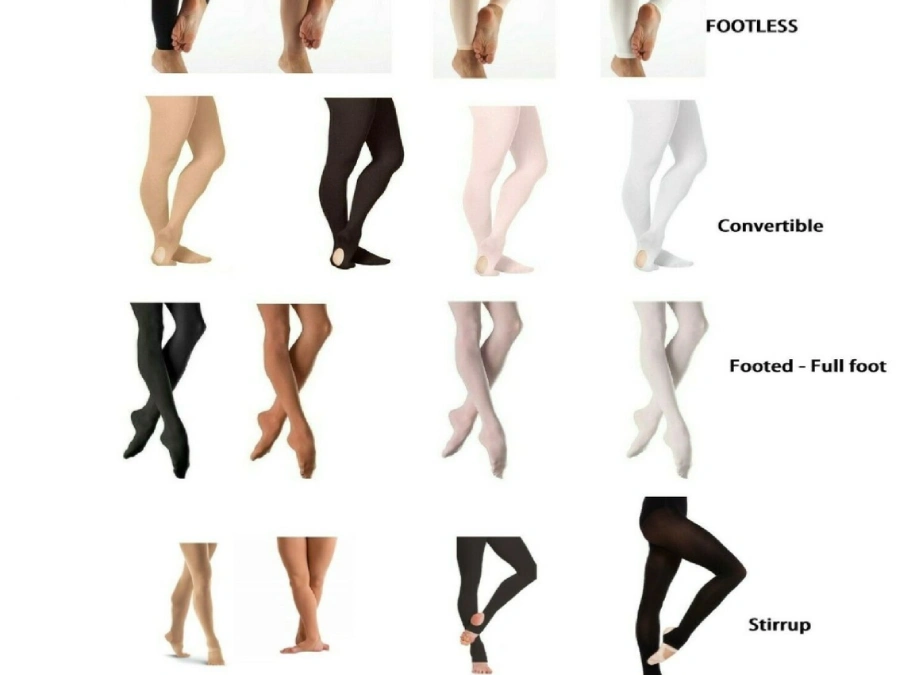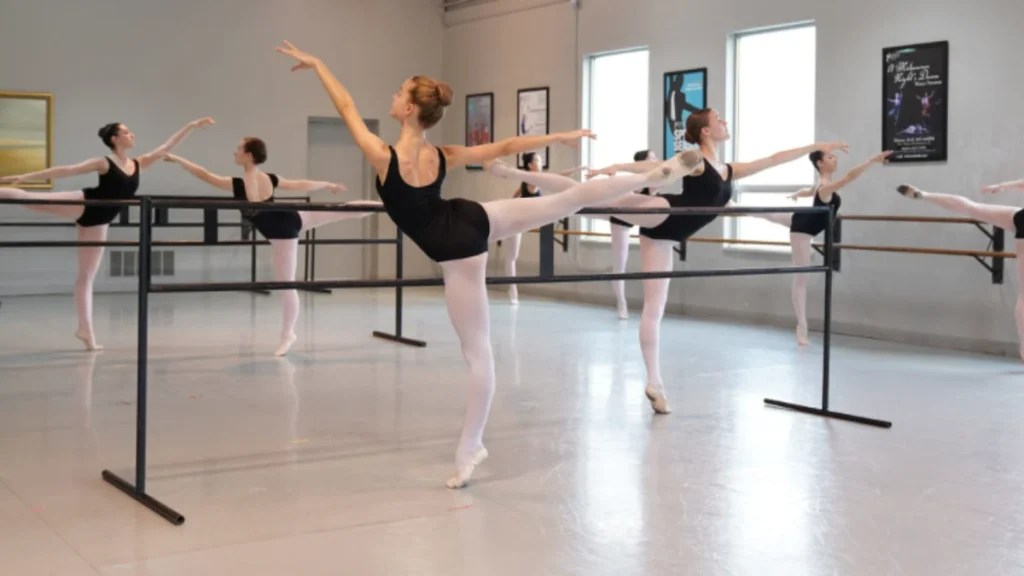Introduction: The mystery of the “hole”

At first glance, a pair of dance tights with a hole in the sole might look defective—like someone snagged them before class even began. In reality, that little circle is no accident. It’s the signature of convertible tights, a clever design that lets dancers pull the fabric aside and instantly bare their feet. They were invented to solve a simple but constant problem: dancers often need both the polished look of footed tights and the freedom of bare skin. Their classic rival, the footed tight, offers a timeless line that ballet masters still insist upon in many classrooms. So which pair belongs in your dance bag? The answer isn’t just about aesthetics; it’s about how you train, perform, and care for your body.
Structure and Design Differences

- Footed tights: These are the original, one-piece standard. They extend seamlessly from the waistband down to the toes. The design hides every contour of the foot, creating the unbroken line ballet is famous for. In shoes, the coverage is invisible but crucial—no gaps, no interruptions, just the illusion of longer, uniform legs.
- Convertible tights: They look identical at first, until you flip the foot over. Here lies a reinforced opening, typically stitched into the sole. With one tug, the dancer can slide the fabric off the heel and toes, converting the tights into a footless version. It’s like a hidden trapdoor: invisible to the audience, invaluable to the dancer.
This design difference, while subtle, changes everything. One favors discipline and tradition; the other favors flexibility and problem-solving.
Convenience: From Shoes to Toes in Seconds
Think of the dancer’s daily routine: multiple classes, rehearsals, and quick stage calls. Time is precious, and small details matter.
- Footed tights excel in stability. Once they’re on, they stay put—no adjustments, no fuss. They slide into ballet flats, pointe shoes, or tap shoes without interruption. For uniform exams or long rehearsals where there’s no need to expose feet, they’re the simplest and most reliable choice.
- Convertible tights shine when things get complicated. Pointe dancers can pop out their toes to add padding, tape blisters, or treat injuries, then cover up again in seconds. Contemporary classes that shift between bare feet and shoes become smoother with the quick pull of fabric. Even backstage, when quick changes are measured in heartbeats, the convertible opening can save precious minutes.
This isn’t just convenience; it’s about maintaining rhythm in a dancer’s day. Where footed tights impose structure, convertibles grant freedom.
Dance Style and Setting Match

Footed Tights: The Traditional Standard
Footed tights are the backbone of classical training. They create the uninterrupted line from hip to toe that ballet aesthetics demand, and they slide neatly into soft ballet shoes, pointe shoes, or tap shoes. Jazz dancers also benefit from the clean, uniform silhouette. In short, they reinforce tradition and discipline, which is why they remain the default in many schools.
Convertible Tights: The Hybrid Performer’s Choice
Convertible tights, on the other hand, appeal to dancers who cross genres. A modern ballet rehearsal might require pointe work in one moment and barefoot floorwork in the next. With a simple pull through the sole opening, dancers can adapt instantly. This makes convertibles especially valuable in mixed repertoires or long rehearsal days where switching between styles is the norm.
Exams and Performance Requirements

Uniformity in Exams
Examination boards like RAD or Vaganova almost universally mandate footed tights in specific shades of pink or white. The reason is consistency: examiners need every dancer to look uniform so that the technical evaluation is not distracted by costume variation. If you are preparing for graded exams, footed tights are not just recommended—they are required.
Flexibility in Performances
Stage contexts tell a different story. Directors may prioritize visual effect or quick changes over uniformity. Convertible tights often shine here. In a production where one dancer performs a ballet variation followed by a barefoot contemporary solo, the opening in the sole can save crucial seconds backstage. For touring companies and competitive teams, that kind of efficiency can mean the difference between a flawless performance and a missed cue.
Cost and Durability
Footed Tights: Economical Reliability
Because they lack the reinforced sole opening, footed tights are usually more affordable. Their even distribution of tension makes them slightly less prone to stress tears, which translates to a longer lifespan under classroom conditions. For schools, parents, or budget-conscious dancers, this makes them the cost-effective workhorse.
Convertible Tights: Versatility with a Price
Convertible tights cost more, but they offer two functions in one garment. The reinforced hole is designed to withstand repeated use, yet it remains a natural weak point compared to the continuous weave of footed tights. Heavy rehearsal schedules may wear them out faster. Still, for dancers who value adaptability, the extra cost is offset by the freedom they provide—one pair can replace two.
Decision Checklist: Footed or Convertible?
Choosing between footed and convertible tights is less about “better or worse” and more about matching the tool to the task. Below is a quick-reference table to help dancers, parents, and teachers make a clear decision:
| Factor | Footed Tights | Convertible Tights |
|---|---|---|
|
Design
|
Continuous coverage
From waist to toes; smooth, uninterrupted line.
|
Sole opening
Footed style with a reinforced opening for quick conversion.
|
|
Best For
|
Classical
Classical ballet, jazz, tap, uniform classes.
|
Hybrid
Pointe training, mixed rehearsals, quick barefoot transitions.
|
|
Exams
|
Required
Mandated by many boards (e.g., RAD, Vaganova) in set colors.
|
Rarely allowed
Check local syllabus; rules can vary by region and year.
|
|
Performances
|
Traditional, uniform stage look.
|
Faster quick-changes; ideal for hybrid/contemporary programs.
|
|
Convenience
|
Stable and simple — “put on and forget.”
|
Fast access for toe pads, taping, or barefoot work.
|
|
Durability
|
Even tension, fewer weak points; tends to last longer in class use.
|
Reinforced opening is a stress point under heavy, repeated pulls.
|
|
Price
|
Generally cheaper.
|
Slightly higher due to reinforced construction complexity.
|
Conclusion

Footed tights deliver classical uniformity for exams and daily training; convertible tights add flexibility and quick transitions for pointe, barefoot rehearsals, and the stage. Together, they cover the studio‑to‑stage spectrum.
👉 Bulk & Custom — For bulk orders, school uniforms, or custom dance tights, contact us to request samples or a tailored quotation. We supply reliable footed and convertible dance tights optimized for classroom consistency and performance versatility.
